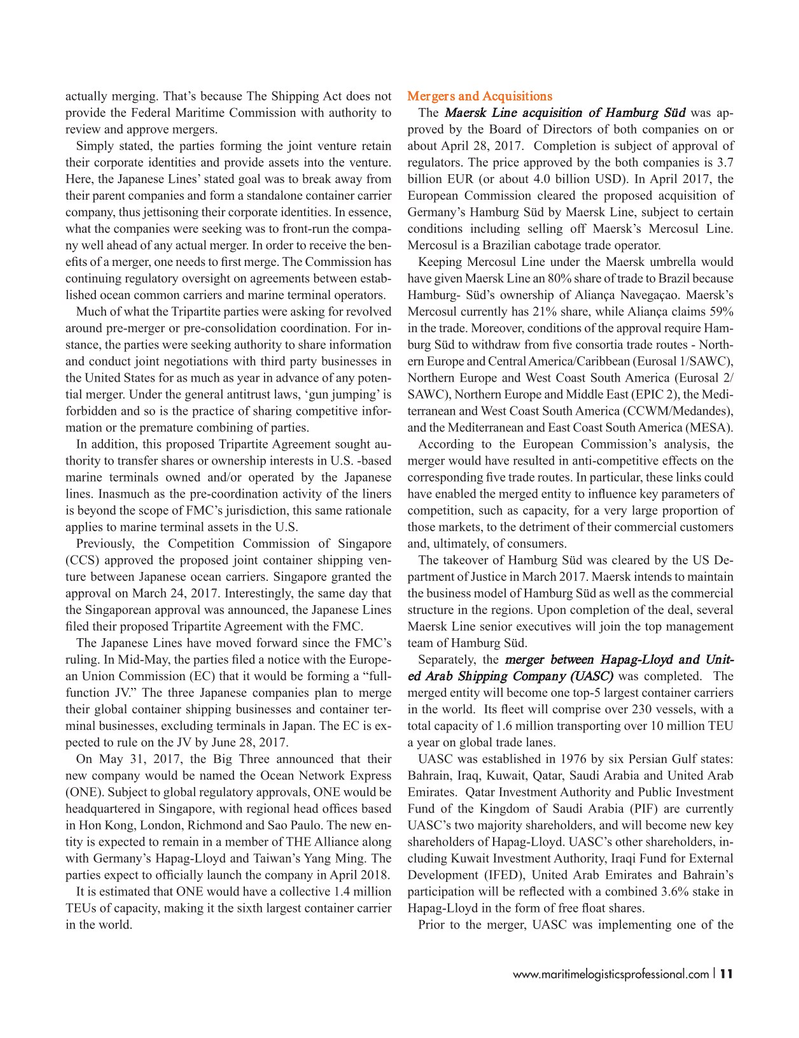
Page 11: of Maritime Logistics Professional Magazine (May/Jun 2017)
BUNKER OPERATIONS & PORTS
Read this page in Pdf, Flash or Html5 edition of May/Jun 2017 Maritime Logistics Professional Magazine
actually merging. That’s because The Shipping Act does not Mergers and Acquisitions provide the Federal Maritime Commission with authority to The Maersk Line acquisition of Hamburg Süd was ap- review and approve mergers. proved by the Board of Directors of both companies on or
Simply stated, the parties forming the joint venture retain about April 28, 2017. Completion is subject of approval of their corporate identities and provide assets into the venture. regulators. The price approved by the both companies is 3.7
Here, the Japanese Lines’ stated goal was to break away from billion EUR (or about 4.0 billion USD). In April 2017, the their parent companies and form a standalone container carrier European Commission cleared the proposed acquisition of company, thus jettisoning their corporate identities. In essence, Germany’s Hamburg Süd by Maersk Line, subject to certain what the companies were seeking was to front-run the compa- conditions including selling off Maersk’s Mercosul Line. ny well ahead of any actual merger. In order to receive the ben- Mercosul is a Brazilian cabotage trade operator. efts of a merger, one needs to frst merge. The Commission has Keeping Mercosul Line under the Maersk umbrella would continuing regulatory oversight on agreements between estab- have given Maersk Line an 80% share of trade to Brazil because lished ocean common carriers and marine terminal operators. Hamburg- Süd’s ownership of Aliança Navegaçao. Maersk’s
Much of what the Tripartite parties were asking for revolved Mercosul currently has 21% share, while Aliança claims 59% around pre-merger or pre-consolidation coordination. For in- in the trade. Moreover, conditions of the approval require Ham- stance, the parties were seeking authority to share information burg Süd to withdraw from fve consortia trade routes - North- and conduct joint negotiations with third party businesses in ern Europe and Central America/Caribbean (Eurosal 1/SAWC), the United States for as much as year in advance of any poten- Northern Europe and West Coast South America (Eurosal 2/ tial merger. Under the general antitrust laws, ‘gun jumping’ is SAWC), Northern Europe and Middle East (EPIC 2), the Medi- forbidden and so is the practice of sharing competitive infor- terranean and West Coast South America (CCWM/Medandes), mation or the premature combining of parties. and the Mediterranean and East Coast South America (MESA).
In addition, this proposed Tripartite Agreement sought au- According to the European Commission’s analysis, the thority to transfer shares or ownership interests in U.S. -based merger would have resulted in anti-competitive effects on the marine terminals owned and/or operated by the Japanese corresponding fve trade routes. In particular, these links could lines. Inasmuch as the pre-coordination activity of the liners have enabled the merged entity to infuence key parameters of is beyond the scope of FMC’s jurisdiction, this same rationale competition, such as capacity, for a very large proportion of applies to marine terminal assets in the U.S. those markets, to the detriment of their commercial customers
Previously, the Competition Commission of Singapore and, ultimately, of consumers.
(CCS) approved the proposed joint container shipping ven- The takeover of Hamburg Süd was cleared by the US De- ture between Japanese ocean carriers. Singapore granted the partment of Justice in March 2017. Maersk intends to maintain approval on March 24, 2017. Interestingly, the same day that the business model of Hamburg Süd as well as the commercial the Singaporean approval was announced, the Japanese Lines structure in the regions. Upon completion of the deal, several fled their proposed Tripartite Agreement with the FMC. Maersk Line senior executives will join the top management
The Japanese Lines have moved forward since the FMC’s team of Hamburg Süd. ruling. In Mid-May, the parties fled a notice with the Europe- Separately, the merger between Hapag-Lloyd and Unit- an Union Commission (EC) that it would be forming a “full- ed Arab Shipping Company (UASC) was completed. The function JV.” The three Japanese companies plan to merge merged entity will become one top-5 largest container carriers their global container shipping businesses and container ter- in the world. Its feet will comprise over 230 vessels, with a minal businesses, excluding terminals in Japan. The EC is ex- total capacity of 1.6 million transporting over 10 million TEU pected to rule on the JV by June 28, 2017. a year on global trade lanes.
On May 31, 2017, the Big Three announced that their UASC was established in 1976 by six Persian Gulf states: new company would be named the Ocean Network Express Bahrain, Iraq, Kuwait, Qatar, Saudi Arabia and United Arab (ONE). Subject to global regulatory approvals, ONE would be Emirates. Qatar Investment Authority and Public Investment headquartered in Singapore, with regional head offces based Fund of the Kingdom of Saudi Arabia (PIF) are currently in Hon Kong, London, Richmond and Sao Paulo. The new en- UASC’s two majority shareholders, and will become new key tity is expected to remain in a member of THE Alliance along shareholders of Hapag-Lloyd. UASC’s other shareholders, in- with Germany’s Hapag-Lloyd and Taiwan’s Yang Ming. The cluding Kuwait Investment Authority, Iraqi Fund for External parties expect to offcially launch the company in April 2018. Development (IFED), United Arab Emirates and Bahrain’s
It is estimated that ONE would have a collective 1.4 million participation will be refected with a combined 3.6% stake in
TEUs of capacity, making it the sixth largest container carrier Hapag-Lloyd in the form of free foat shares.
in the world. Prior to the merger, UASC was implementing one of the www.maritimelogisticsprofessional.com 11I

 10
10

 12
12
